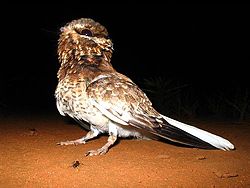| Eleothreptus | |
|---|---|
 | |
| White-winged nightjar (Eleothreptus candicans) | |
| Scientific classification | |
| Domain: | Eukaryota |
| Kingdom: | Animalia |
| Phylum: | Chordata |
| Class: | Aves |
| Clade: | Strisores |
| Order: | Caprimulgiformes |
| Family: | Caprimulgidae |
| Subfamily: | Caprimulginae |
| Genus: | Eleothreptus Gray, GR, 1840 |
| Type species | |
| Amblypterus anomalus Gould, 1838 | |
Eleothreptus is a genus of South American nightjars in the nightjar family Caprimulgidae.






